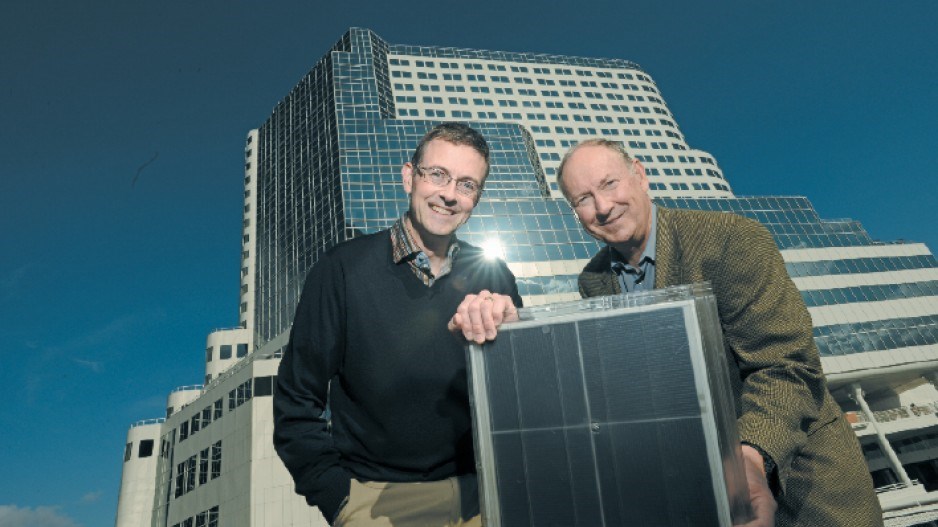From a distance, the new roof on Magnolia Gardens seniors home in Langley looks, well, new. Shiny and new.
The reason it’s shiny is that a section of the roof is laced with photovoltaic panels that will generate 2.5 kilowatts of electricity – about half of the building’s power needs.
The new solar roof is the first commercial installation by MSR Innovations, a Surrey-based company that has designed and patented a new approach to building integrated photovoltaics (BIPV) roofing.
MSR’s SolTrak system is not a typical solar array mounted on a roof, it’s a system of photovoltaic roofing tiles. The entire roof can be covered with them, or only a section, as is the case at Magnolia Gardens.
MSR Innovations isn’t the only player in the growing BIPV space, but the company’s co-founder and CTO, Tim Roddick, thinks his company has an edge in developing a system that any roofing contractor with some training can install.
“We’ve designed a system to be quick to install. Our differentiator is that we can put it on faster and cheaper.”
That’s “cheaper” – not “cheap.”
The Magnolia Gardens demonstration system cost $1.8 million, according to Sustainable Development Technology Canada (SDTC), one of the funding partners.
SDTC’s contribution was $680,000. The provincial Innovative Clean Energy (ICE) fund contributed $336,000. MSR Innovations and Century Group, the building’s owner, covered the balance ($750,000).
SDTC invests in Canadian-made technology that it believes has good export market potential and helps get it to the commercial stage.
“You’ve got to show it in your backyard first,” said Rick Whittaker, SDTC’s vice-president of investments and chief technology officer.
Although Magnolia Gardens is a commercial installation, MSR plans to focus on the residential market.
The esthetics of rooftop solar arrays on commercial buildings aren’t as big an issue as they are in residential neighbourhoods, said MSR Innovations CEO Jim Thompson. Integrated into the roof itself, solar tiles don’t look much different from asphalt tiles.
“Now you’ve dealt with the ugly factor,” Thompson said. “Secondly, because of the design of the mounting system of the panels themselves, you can drive the cost out of the system, which is key to getting acceptance in the residential market.”
The company estimates it will cost $25,000 to $30,000 to install a SolTrak system on 2,500-square-foot roof.
“It costs roughly the same as a premium roof but you get the solar for free,” Roddick said. “It will cut your [power] bill in half.”
Although the company hopes to build more solar roofs here, Roddick concedes B.C. may not be the best market for the SolTrak system, and not just because it lacks sun. Germany, after all, marked a milestone in May when 50% of its power was supplied by solar. But B.C. has relatively cheap, clean hydro power, which means the return on investment is much longer here than places like California, which is willing to pay more for power generated by homeowners.
Unlike California, there are no grants or other incentives offered to homeowners to cover the premium of installing a solar roof in B.C. BC Hydro does offer net metering, however, where homeowners and businesses that generate their own power can sell their excess electricity. According to BC Hydro, the utility has 260 net metering customers, 238 of whom have solar power.
The biggest market in North America for BIPV is California, said Nelson Switzer, PwC’s Eastern Canada lead for Sustainable Business Solutions.
“They have a subsidy program and they’ve got great sunshine,” he said.
He added that, although California gets more sunlight, B.C. has longer days, not to mention a population that is keen for green, so there may well be some early adopters in B.C.
Japan is also a potentially big market.
“If you were to cover just a fraction of the rooftops in Japan, you could power the country,” Switzer said.
Global solar skin market estimated at $10 billion
Building integrated photovoltaics (BIPV), also known as solar skin, is the integration of solar photovoltaic panels into the building envelope – walls, windows or roofs – when they are built to provide some of the building’s electricity. A number of office towers in Europe and Asia have been built using BIPV windows.
NanoMarkets, an industry analysis firm, estimates the global BIPV market for roofing will be worth US$3.9 billion by 2016 and the BIPV glass market will be worth US$6.4 billion.




